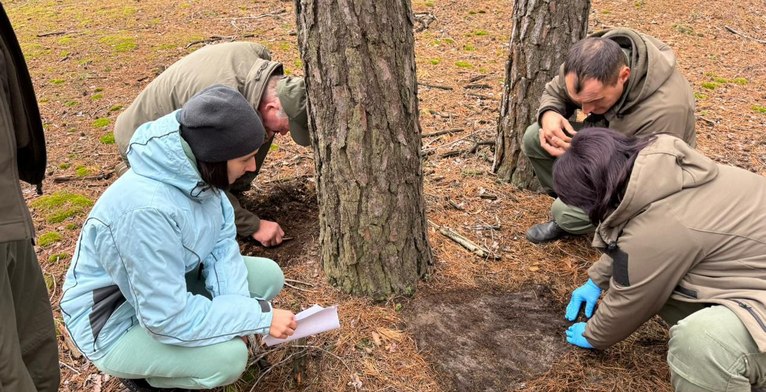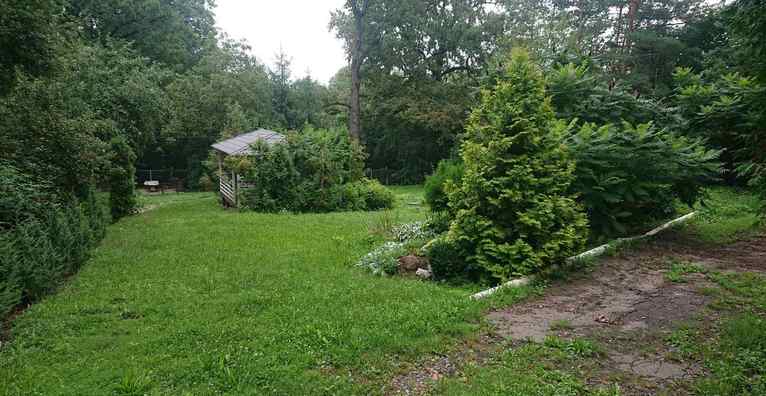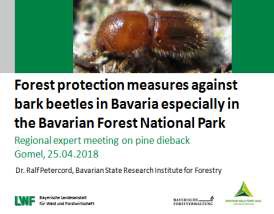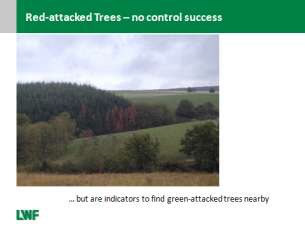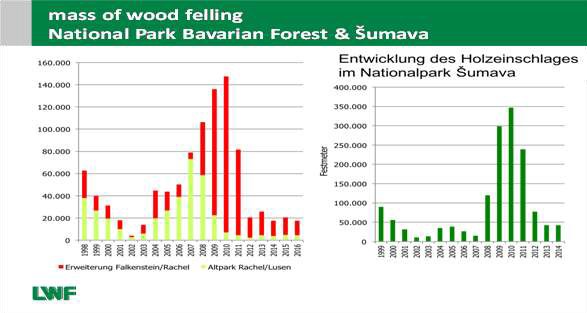The international seminar "Protection of Pine Stands from Pests and Forest Diseases" (Regional workshop on combating dieback of pine forests) took place in Gomel. Over three days (April 24-26), scientists and foresters from Belarus, the USA, Germany, Italy, Hungary, Russia, and Ukraine discussed the problem of pine stand dieback, methods for early detection of pest outbreaks, and forest protection measures. The seminar was organized by the Food and Agriculture Organization of the United Nations (FAO) and the Ministry of Forestry of the Republic of Belarus.
From Ukraine, participants included senior researcher of the Forest Protection Laboratory of UkrNDIDGA, PhD in Agricultural Sciences Yu.Ye. Skrylnyk, director of the State Specialized Forestry Enterprise "Kharkivlisozakhyst" K.V. Davydenko, director of the State Specialized Forestry Enterprise "Khersonlisozakhyst" T.G. Kasich, and director of the State Enterprise "Ivankivske LG" of the Kyiv Regional Forestry and Hunting Management O.M. Katsalap.
The seminar was opened by the First Deputy Minister of Forestry of Belarus, Alexander Kulik, who emphasized the importance of such a high-level seminar for the forestry sector of Belarus, as combating the widespread dieback of coniferous stands in many regions requires cooperation between foresters and scientists from different countries.
Scientific evidence confirms the intensive changes in the Earth's climate system, particularly related to increased greenhouse gas emissions. To mitigate the effects of climate change, forest stands must be able to adapt, as forests play a crucial role in the planet's climate balance through carbon absorption (Robledo, 2008).
In Ukraine, most forest stands are of artificial origin, with many being monocultures growing at the limit of possible forest existence. These stands are particularly vulnerable to pests, diseases, and anthropogenic factors. As a result, persistent outbreaks of mass pest reproduction and disease spread exist and will continue to exist in most regions of Ukraine, even in forested zones where microclimatic conditions favor forest dieback (Meshkova, 2014).
The problem of "bark beetle-induced pine dieback" exists in many countries as a result of unfavorable weather conditions (several years of drought) and anthropogenic factors.
The seminar began directly in the forest stands of the Gomel region, where the first outbreaks of the spruce bark beetle were detected in 2015, and in 2016, the first sanitary and improvement measures were conducted in the southern part of the region. Alexander Kulik reported that in 2017, the area of clear sanitary fellings reached about 30,000 hectares throughout Belarus. He also noted that the Belarusian forest protection service, together with scientists, developed an algorithm for the urgent localization of bark beetle outbreaks, focusing on their timely detection, removal of harvested wood and logging residues for processing, or at least shredding. Additionally, he mentioned that pheromone traps produced by the Institute of Forest of the National Academy of Sciences of Belarus allow timely detection of new beetle outbreaks (but do not eliminate them!).
Experts and seminar participants examined the clear sanitary fellings of 2017 and 2018, fresh bark beetle settlements (after wintering) on model trees, and pheromone traps installed at least 25 meters away from the forest edge. Massimo Faccoli, an expert from Italy, recommended placing pheromone traps at a distance of at least 30, preferably 40–50 meters from the forest edge, as traps placed too close to the forest attract beetles not only into the traps but also directly into the forest.
After the field inspections, the seminar continued at the Institute of Forest of the National Academy of Sciences of Belarus. The plenary session was opened by the First Deputy Minister of Forestry Alexander Kulik and the institute's director, Professor O.I. Kovalevich, who briefly outlined the institute's work and the joint efforts of scientists and foresters in forest protection. Nikolay Yurevich, head of the forestry department of the Ministry of Forestry of Belarus, reported that in 2017, the area affected by bark beetles reached 130,000 hectares, with clear sanitary fellings planned for 29,000 hectares and selective fellings for 47,000 hectares. As of March 2018, the total area of bark beetle-affected forests reached 54,000 hectares, with 10,000 hectares already removed by clear fellings.
In 2018, 12,000 pheromone traps were deployed across Belarus, produced by the Forest Research Institute in Gomel. Unfortunately, scientists determined that pheromone traps are not sufficiently effective for protection and can only be used for monitoring bark beetle spread in stands. Nikolay Yurevich stated that in areas of mass beetle reproduction, freshly infested trees are removed in accordance with Recommendations for Sanitary and Improvement Measures and current legislation.
He also noted that, unfortunately, there are currently no methods for early diagnosis of freshly infested trees. Therefore, the main focus of the seminar was to gain experience from foreign experts on detecting bark beetle outbreaks and implementing integrated forest protection measures.
Dr. Massimo Faccoli (Italy) reported that bark beetle outbreaks have spread over vast areas of Italian forests for the past 30 years, with the most intense outbreaks recorded in the Southern Alps. Scientists and foresters use a three-step algorithm to localize bark beetle infestations: 1 – population monitoring, 2 – risk assessment of spread, and 3 – control strategies. Since 1994, Italian scientists have observed three major outbreaks, with a population increase starting in 2015.
Scientists conduct visual inspections, map infestation sites, and monitor population dynamics using pheromone traps. Dr. Faccoli noted that in Gomel Region, Belarus, 400 traps are sufficient, but it is crucial to select “reference” sites where traps reflect population trends accurately.
Determining flight periods for each region is essential. In Italy, flight dates in the Southern Alps and the north differ by several weeks. First-generation beetles establish new infestations, while second-generation beetles expand existing ones.
Italian scientists continuously monitor climatic factors, tree health, and pest development to predict population dynamics. They use data for pest risk assessment (PRA) to evaluate the potential spread of bark beetles and other pests. Pheromone traps track populations during the vegetation period, recording temperature, precipitation, and other parameters. Dispensers in traps are replaced in June between peak flights. Traps are placed in clearings 30–50 meters from the forest edge, with 2–3 traps per hectare for reliable data. “One to three traps per 20–30 hectares are not sufficient,” Dr. Faccoli emphasized.
The third crucial step is defining control strategies. Different strategies were developed for southern, northern, and mountainous regions of Italy. In the Southern Alps, sanitary clear-cutting, trap trees, and localized chemical treatments were used. However, chemical treatments were later discontinued due to regulations and high costs.
Sanitary logging was conducted within a year after monitoring. First-generation beetles create new hotspots, while the second generation expands them. Timber was removed via helicopters, and remaining wood was debarked or treated with insecticides, though these methods were expensive and ineffective for large areas.
Pheromone traps were placed in high-risk zones where other measures were unfeasible, using up to 12–15 traps per hectare. This method captures 30–60% of the beetle population but does not eliminate outbreaks. Trap trees were felled and left at infestation sites, while pheromone traps at logging areas were emptied weekly.
According to scientists, it is necessary to experimentally determine the threshold number of bark beetles in pheromone traps for monitoring outbreaks and predicting their spread or decline. For example, in Italy, a count of 8,000 bark beetles (in Belarus, it is 3,000 per trap per week) in a single pheromone trap per week indicates an expanding outbreak, requiring control measures. If the first generation's population is larger than the second, it signals a decline in the pest population, meaning no measures are needed except monitoring. However, if the first generation is smaller than the second, it indicates an outbreak development and spread.
Dr. M. Faccoli suggested that a similar three-step strategy could be applied in Ukraine for localizing bark beetle hotspots.
Dr. Rolf Petercord (Germany) shared insights on monitoring and controlling the spruce bark beetle in Bavaria's National Park, where multiple outbreaks have been recorded since 1981.
In the park, continuous monitoring is conducted using visual inspections (damage assessment), pheromone traps (200-400 traps annually across 24,500 hectares), model trees for assessing population density and viability, and climate parameters.
German scientists and foresters classified spruce trees in risk zones as green (healthy but at risk), gray (recently infested), and red (dead). Cutting red trees is ineffective, so they are left to maintain biodiversity, while only gray and green trees are removed.
Unfortunately, the bark beetle outbreak could not be eradicated through logging but was localized within specific park areas where freshly infested trees could be removed. In 2017, the park suffered €3.1 million in losses due to the beetle, which destroyed over 5 million cubic meters of wood, especially in mountainous and restricted logging areas.
Pheromone traps have not been used as a control measure in Germany for decades. Today, they are used only for monitoring bark beetle populations, as studies show they capture only 15-50% of beetles (10 traps per hectare), making them ineffective for population control but useful for monitoring outbreak boundaries.
Western United States and Western Canada:
Mountain pine beetle (Dendroctonus ponderosae)
Spruce beetle (Dendroctonus rufipennis)
Western pine beetle (Dendroctonus brevicomis)
Douglas-fir beetle (Dendroctonus pseudotsugae)
Engraver beetles (Ips spp.)
Southern United States:
Southern pine beetle (Dendroctonus frontalis)
Engraver beetles (Ips calligraphus)
Mexico and Central America:
Southern pine beetle (Dendroctonus frontalis)
Round-headed pine beetle (Dendroctonus adjunctus, Guatemala)
Engraver beetles (Ips calligraphus, Caribbean)
A researcher explained the importance of monitoring each pest species, emphasizing the necessity of studying their biology and phenology while considering regional climatic conditions. He highlighted control strategies for Ips calligraphus and Dendroctonus frontalis, which damage pine forests across North and South America.
Preventive measures focus on maintaining healthy forests, minimizing tree damage during logging, and promptly removing infested trees. Felled trees infested with beetles must be immediately removed, while high-value trees should be treated with insecticides. Already dead trees, colonized by beetles, no longer pose a threat and are left to decompose naturally. The researcher noted that logging does not eliminate infestations but only helps contain them. The primary goal of these operations is to reduce beetle populations and harvest wood with minimal quality loss.
For each beetle species, a buffer zone is determined to apply the Cut-and-Leave method: felling and leaving trees until the next beetle generation emerges, after which they are removed. The size of the buffer zone and logging timing depend on the beetle species and its phenology.
For one of the most dangerous beetles in America, a 100-meter buffer zone was established, leaving trees within the zone.
Dr. Billings stated that control strategies are developed by scientists for each beetle species, considering regional climate, pest biology, and country-specific conditions.
Dr. Shiroma Satipala from the FAO Forest Protection Department thanked experts for their reports and provided insights into global forest decline due to climate change and human activity, as well as the rising threat of invasive pests and diseases. Approximately 35 million hectares of forests worldwide are affected by pests and diseases annually, with about half of these damages caused by trunk pests.
Professor V.V. Usenya from the "Institute of Forest NAS of Belarus" briefly reported on pine forest decline in Belarus and recommended monitoring and containment strategies for Ips beetle outbreaks. Scientists, in cooperation with forest protection services, conduct pheromone monitoring for Ips beetles based on a methodology established in 2017. According to this methodology, sanitary measures are required when pheromone trap captures exceed 3,000 individuals for Ips beetles and 300 individuals for six-toothed bark beetles. He also outlined key research directions for growing and maintaining healthy forests.
The director of Khersonlisozakhyst, T. G. Kasich, spoke about the dynamics of the spread of drying stands in Ukraine and the specifics of the distribution of the top bark beetle in the western and central regions. She presented monitoring results from Volyn region, three-year data on temperature regimes, precipitation, and groundwater levels in pest outbreak areas. Additionally, she reported on the identification of the fungus Ophiostoma picea on the surface of Ips acuminatus, one of the most widespread fungi of the ophiostomoid group associated with bark beetles.
Professor V. B. Zvyagintsev (Belarus) provided information on the spread of root rot outbreaks in Belarusian forests and the trend of top bark beetle outbreaks in stands affected by root rot. He noted that in most cases, the outbreaks border each other, with the top bark beetle colonizing trees on the periphery of root rot areas and spreading further into the stand. It was also mentioned that in 2019, production of a biological agent against root rot based on antagonistic fungi was planned.
Elena Feingold's report focused on the use of remote sensing data for monitoring and early detection of bark beetle outbreaks. The use of freely available satellite images with a resolution of 10 and 30 meters (Landsat-8, Sentinel-2) allows for the assessment of vegetation moisture levels, greenness index, and photosynthetic activity. At the initial stage of bark beetle infestation, the canopy color does not change, but moisture content decreases. Images are processed using various filters to detect the boundaries of infested forest areas, which are then verified through ground surveys. This technology can also help detect other forest canopy disturbances, including illegal logging.
The report by Russian experts O. I. Petrov and V. O. Lipatkin was dedicated to the potential use of xylophilous insects as indicators of tree physiological condition. On drying trees, a “standard” xylosaprotrophic species complex forms. Determining ecological indicators of bark beetles (fertility, viability at different stages, the number of maternal tunnels per family, etc.) allows for tracking population dynamics trends.
Dr. Norbert Winlak, a representative of the FAO Regional Forestry Protection Office, also thanked the experts and participants for their reports, especially the Belarusian foresters for organizing the seminar at a high level. He noted that cooperation with FAO international experts, scientists, and foresters from other countries enables the development of strategies for pest and disease monitoring and control, as well as the creation of resilient forest plantations.
During the seminar, participants visited the laboratories of the Institute of Forest of the National Academy of Sciences of Belarus, including the Genetics and Biotechnology Laboratory. This laboratory conducts genetic and selective research on forest plantations, studies the molecular-genetic mechanisms of tree pathogenesis, develops molecular phytopathological monitoring technologies, preserves valuable tree genotypes using biotechnological methods, and cultivates microclonally propagated planting material.
They also visited the Laboratory of Forest Restoration, Protection, and Conservation, which explores ways to restore forest phytocenoses, studies the biology and ecology of forest pests and diseases, and investigates mechanisms for regulating these factors under anthropogenic pressure. Additionally, participants toured the Genetic Seed Bank of forest tree species, established to conserve the genetic fund of Belarusian tree species using ex situ conservation methods.
The meeting was highly beneficial, as it allowed establishing connections with specialists from other countries and learning about forest protection issues and their solutions.
Director
State Forest Protection Enterprise "Kharkivlisozakhyst"
K.V. Davidenko
Attached, you can find the presentations discussed during the seminar:
Remote sensing for monitoring and early detection of bark beetle disturbance - Yelena Finegold
Forest protection measures against bark beetles in Bavaria - Dr. Ralf Petercord
Management of bark beetle outbreaks in SE Alps - Massimo Faccoli




